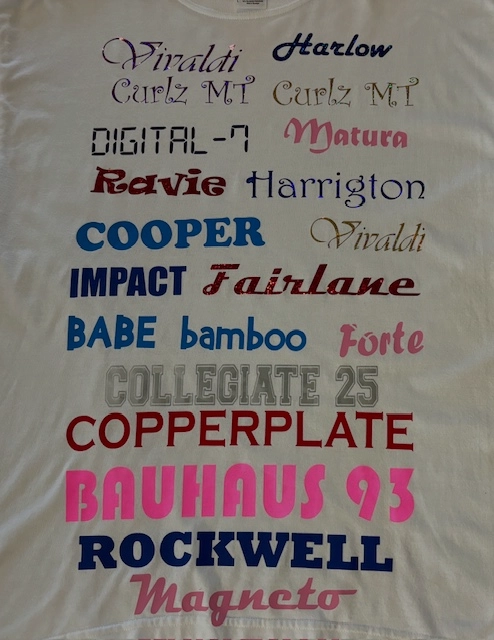Classy Monogramming on Towels for a Touch of High-end
Classy Monogramming on Towels for a Touch of High-end
Blog Article
The Art of Custom-made Embroidery: Unlocking the Tricks to Creating Unique and Unforgettable Designs
Embroidery, a craft soaked in tradition and artistry, holds within its detailed stitches the power to transform fabric into a canvas of special expression. The tricks to developing custom embroidery styles that astound the eye and leave a lasting perception hinge on a fragile balance of technique, creativity, and interest to detail. As we explore the world of custom-made needlework, we uncover the nuanced interplay in between string selection, sew intricacy, and layout personalization that raises a simple garment to an artwork. Join us on a trip via the art of personalized embroidery as we unwind the enigmas behind crafting absolutely unforgettable and distinct creations.
Choosing the Right Needlework Threads
When choosing embroidery threads, what key aspects should you consider to ensure the most effective results for your custom-made designs? The selection of needlework thread is vital in figuring out the final end result of your stitched layout. One of the key considerations is the material of the string. Different products such as cotton, polyester, rayon, and silk use differing degrees of luster, toughness, and structure. It is important to choose a thread material that complements the material you are stitching on and straightens with the desired look of the layout.
Thicker strings can add measurement and texture to your layout, while finer strings are perfect for elaborate information and tiny text. Additionally, thinking about the shade fastness and washability of the thread is important to make certain that your personalized layouts maintain their top quality and vibrancy over time.
Discovering Various Stitch Techniques
To look into the realm of 'Discovering Various Stitch Techniques', one have to realize the complexities and subtleties that each sewing approach brings to the art of embroidery. Different stitch strategies not just add visual interest yet likewise add to the general appearance and measurement of the design. One prominent stitch strategy is the satin stitch, which includes closely stuffed parallel stitches to develop a smooth and shiny surface, suitable for loading in shapes and producing bold describes.
On the other hand, the backstitch is a flexible strategy frequently utilized for describing and including great information. It entails sewing in reverse to develop a strong line of needlework. Additionally, the French knot stitch adds a responsive aspect to designs, best for creating textured accents like blossom facilities or decorative touches.
Exploring various stitch methods permits embroiderers to play with light, shadow, and depth within their styles, raising the aesthetic appeal and artistic top quality of their needlework jobs. By grasping various stitching approaches, one can open unlimited possibilities for developing unique and memorable custom needlework items.
Incorporating Personalized Layout Aspects
Having discovered the intricacies of different stitch techniques such as the satin stitch, backstitch, and French knot, the emphasis currently changes towards integrating personalized style components in custom embroidery jobs. Customized layout components play an essential role in making needlework projects truly distinct and remarkable.
One more way to integrate customized layout components is by including icons or concepts that hold special definition to the recipient or show their interests and individuality. Integrating a favorite flower, animal, or hobby-related sign can make the needlework design extra significant and personalized. Furthermore, selecting colors that reverberate with the recipient or straighten with the designated motif can browse this site further improve the customization of the embroidery project.
Understanding the Art of Color Coordination

One secret aspect of color control is comprehending color concept. This includes understanding exactly how various shades engage with each various other, the feelings they share, and exactly how they can be incorporated to produce aesthetically appealing styles. By using shade theory principles, embroiderers can produce harmonious shade schemes that improve the link overall look of the layout.
Furthermore, focusing on comparison is crucial in color control. Using contrasting shades can help particular elements of the design pop, enhance readability, and develop an aesthetically vibrant embroidery piece. By mastering the art of shade control, embroiderers can elevate their layouts and develop remarkable items that resonate with customers and visitors alike.
Enhancing Structure With Advanced Embroidery Stitches

French knots, for instance, are best for adding tiny, elevated dots to your layout, imitating the appearance of grains or developing a textured surface. Bullion knots, on the other hand, can be used to create twisted, ropelike aspects that include a luxurious feel to the embroidery. Seed stitching entails little, scattered stitches that can fill out areas with a polychromatic structure, while turkey work develops fluffy, dimensional accents similar to animal hair or vegetation. Explore these advanced embroidery stitches permits you to press the limits of conventional embroidery and create genuinely one-of-a-kind and visually enticing textures in your styles.
Verdict
Finally, the art of custom embroidery entails a combination of choosing the ideal threads, checking out various stitch strategies, integrating individualized layout elements, mastering shade sychronisation, blog here and boosting appearance with sophisticated stitches. By recognizing and applying these vital aspects, embroiderers can develop one-of-a-kind and remarkable styles that showcase their imagination and skill. Embroidery fanatics can unlock the tricks to developing beautiful and bespoke pieces that stand apart and leave a long-term impression.
Report this page